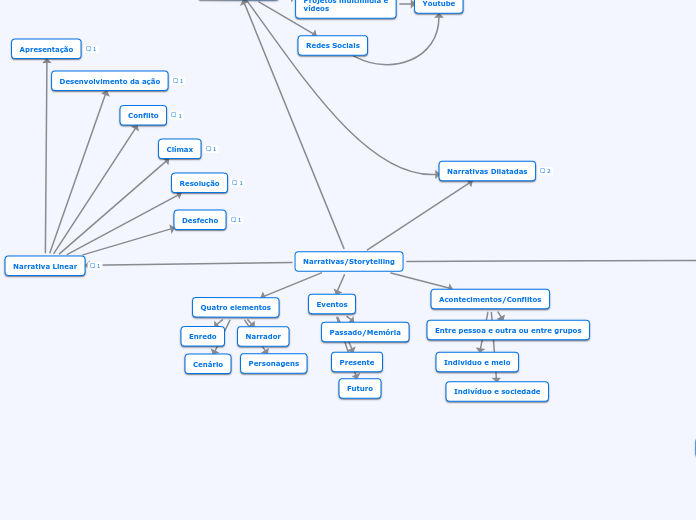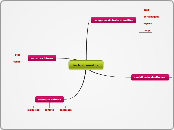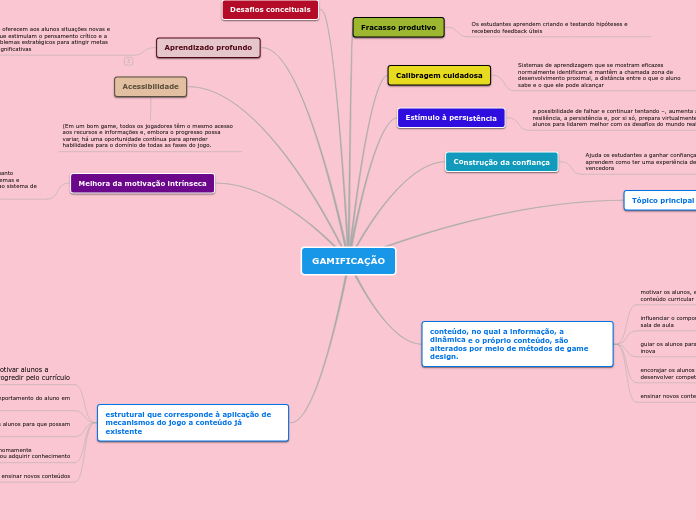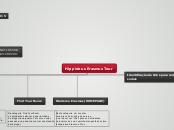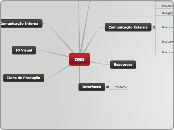Narrativas/Storytelling
Narrativas Dilatadas
Presença de um prólogo sem a música, com apresentação de personagens, ações, caracterizações, inclusão de falas e diálogos.
Podemos associar a questão da exposição visual e narrativa de Bruce Block. Ao iniciar a música, uma série de artimanhas de composição fílmica podem ser usadas a partir das configurações das linguagens audiovisuais sincronizadas ao ritmo musical e imagético. Nos videoclipes contemporâneos, as performances das personagens não estão condicionadas ao tempo exato da música, pois existe a possibilidade de inserção de diálogos incorporados
ou não à canção. Estabelece-se um clímax nas situações narrativas com um resolução sem a música, geralmente ao finalizar o videoclipe.
Gamification
Utilização de elementos de jogos em contextos não-lúdicos. Uma implementação comum da ludificação/gamification é pegar em elementos de pontuação dos videojogos, tais como pontos, níveis e conquistas e aplicá-los a um contexto profissional ou educativo.
Modelo AIDLET
Thematic value and adequacy
These are perhaps the most subjective of all the components in the model: what is “valuable” and what is “adequate”? These are important criteria because we have to consider information that is relevant to a specific culture, society, group or organization. Many games and simulations will not be suitable for adoption because of issues related to religion, politics or race, for example. On the other hand, many games and simulations were developed to engage players in a very respectful game play, for instance, World Without Oil, Food Force or 3rd World Farmer, but may not be suitable for the specific learning goals set out in the curriculum. Furthermore, some games and simulations may be too restrictive and prevent students from developing their own meanings,
interpretations and critical views. This also means inquiring what instructional activities can be created to maximally address weaknesses of the game (e.g., missing, misleading or inaccurate content). Other essential aspects to evaluate are the topics breadth or depth, and the types of strategies that are promoted by a game (e.g., trial and error, problem-based, etc.).
Engagement and ease of play
This aspect usually becomes apparent only after students start playing a game, interacting with a simulation, or using AR, when participants become excited and joyful about it. Here, as well as in television contests, there must be a challenge that the player can understand and may be able to succeed at by using his or her knowledge, intelligence, and dexterity. To be engaging an educational game or simulation must be composed of purposeful, goal-oriented, rule-based activities that the players perceive as fun. This means that we must be aware of any signs of either cognitive overload or excessive dispersion of attention in the players that may impair learning activities. A preliminary test period with a game or simulation is a must and may be accomplished with a small group of volunteers using representative equipment.
Learning design potential
The best way to see the instructional benefits of specific games and simulations is to evaluate how they are used in education. For example, evaluating the
performance of titles in the socalled “Serious Games” genre, namely,
investigating the kinds of learning that may be supported, the instructional
strategies that are possible within each game constraints, the e-learning
platforms and technologies that are compatible. Only when students feel
comfortable with the online environment and the technology provided will they
be able to study and contribute. On the other hand, excessive involvement with
games and simulations may damage the interaction with other course content and with other students, and this certainly needs to be monitored closely.
Distance education workflow integration
Learning with the new digital tools really implies much more than just using intensively a given set of applications: it comprises all the human factors and qualified work involved in conceiving appropriate learning materials, devising a sound pedagogical strategy, providing each student with efficient support, assessing individual progress, grading students, and certifying their final results. So many questions arise: how games and simulations integrate with a distance education workflow? How do we monitor student’s activity? What if the students do not visit all the areas in the game/simulation? What if they wander around wasting time? How much time and effort is necessary to accomplish all the tasks? How do we assess the students? Etc. Of course, there is no ready answer to these questions; the idea is to figure out the answers specific to each
project before going any further. In the case of blended learning the online
component has to be programmed and adjusted to the requirements of face-to-face teaching, with a proper integration of games, AR and other resources. An
essential aspect is to make sure that every one has a mobile device with the
minimum requirements for access and interaction.
Interaction and communication capabilities
Games and simulations are by definition very interactive yet not all of them support useful educational interaction that leads to effective learning. Furthermore, the quantity of interaction that is possible with a system does not guarantee the quality of the interaction in terms of attaining learning goals. A sense of security and progress is important and depends both on the ends to be pursued and on the means to achieve them. The design of the interactions is vital to the success of the game/simulation as these are initial requirements that make or break the deal. A poorly made design will never be used by students no matter the amount of research and development that was spent in the project.
Also some essential Web 2.0 features of cloud applications are important to
enable connection with other people and resources, not only for support, as is
usually the case to tackle technical problems, but to achieve strong motivational and multiplying effects that facilitate learning. The current boom in social networking is a solid indicator of this requirement.
Availability and cost
The widespread use of games as entertainment is a known fact but it doesn’t mean that games in general are effective for learning purposes. Some games can be selected and used to assist the learning process and others have to be designed from scratch to support a specific course. The first decision is whether to consider the repurposing of an existing title or the development of a new game.
There are basically three options: get an “off-the-shelf” title, contract with
a development firm or get in-house production. The costs are very different and
tend to increase from the first to the latter. There is no stable and robust
model to use here as it all depends on the instructional design to be used and
the budget on hand. For instance, learning history with Sid Meyer’s
Civilization is quite inexpensive, because the title is widely available at
affordable prices, while developing a game for a new course on
telecommunications surely has a prohibitive price. Today, there is also an
enormous amount of free games available in both the Apple Store and Google Play repositories, not to mention the apps and other educational resources that can be installed in tablets and smartphones. The consideration of AR games may be also a viable alternative as some free apps are available for learning
purposes.
Avaliação
As histórias e os portefólios em suporte digital dos estudantes devem ser avaliados através de
critérios claros, como por exemplo:
- Objetivo geral da história
- Ponto de vista do narrador
- Uma pergunta (ou perguntas) dramáticas
- Seleção de personagens e cenários
- Escolha e valor dos conteúdos
- Clareza de argumentação
- Ritmo da narrativa
- Uma banda sonora que seja significativa
- Qualidade das imagens/vídeo
- Economia de detalhes da história
- Boa gramática e uso da língua
- A atualidade da narrativa digital
Estimular o debate e a reflexão no domínio da diversidade em contextos educativos e analisar as suas implicações na vida académica e no sucesso dos estudantes.
Tópicos centrais como a “diversidade”, “língua”, “cultura”, “relações interculturais”, “comunicação”, “identidade”, “interações professor/estudante” devem ser abordados como formas de aprender a lidar com a complexidade da diversidade humana e social e compreender os seus benefícios e vantagens. Os debates e as reflexões devem ser orientados no sentido de ajudar os estudantes, quer a desenvolver a consciência da diversidade, quer a melhorar o diálogo com o outro.
Atividades de aprendizagem
Atividades em equipas ou a estudantes individualmente que podem ser utilizadas antes do desencadear da história:
- Provocar um brainstorm entre os estudantes
- Incitar os estudantes a organizar e valorizar as suas ideias
- Fazer os estudantes pesquisar o tópico proposto
Durante o desencadear da história:
- Direcionar os estudantes para a identificação e anotação de palavras-chave
- Dar aos estudantes um trabalho de resumo (da história)
Seguir do desencadear da história:
- Pedir aos estudantes para criarem um guião e cartões para storyboards
- Facilitar a discussão dos principais tópicos da história
- Definir projetos multimédia adequados: fotogramas, vídeos, PREZI
- Retratar um membro da família, amigo ou colega
- Entrevistar e fotografar uma celebridade local
- Homenagear a memória de uma pessoa já falecida
- Preparar uma biografia de uma pessoa interessante
- Criar uma história composta sobre as realizações conseguidas pela equipa (making of…)
Estratégias e objetivos pedagógicos
Variam de acordo com as áreas de conteúdo específicas mas podem mencionar-se alguns exemplos típicos de estratégias para aplicação de narrativas digitais, incluindo a criação de novas narrativas por parte dos estudantes:
- Aquisição de novas perceções e léxicos
- Desenvolvimento de competências de escrita e de leitura
- Integração de competências de investigação na criação de narrativas
- Utilização de competências organizacionais e de gestão do conhecimento
- Desenvolvimento de competências de resolução de problemas
- Desenvolvimento de competências de literacia visual
- Integração significativa de palavras e de imagens para fins comunicacionais
- Promoção da criatividade e formas de expressão pessoais
- Desenvolvimento das competências tecnológicas
- Melhoria da literacia informacional
- Fomento das competências de apresentação
Preparação para professores
Os professores devem ter em mente que tanto a apresentação como a criação de narrativas digitais
devem obedecer a determinados requisitos operacionais, nomeadamente:
- Acesso a tecnologia: hardware e software
- Formação com tecnologia (deve ser de fácil utilização)
- Tempo a consagrar (deve ser controlado)
- Integração em disciplinas curriculares
- Orientações claras para atividades a realizar
- Não confundir atividades e realizações
- Requisitos de avaliação
- Privacidade, questões de adequabilidade
- Violação de copyright e de utilização legítima de imagens e música
Objetivos didáticos
O primeiro objetivo é integrar a narrativa digital no curso utilizando este caso específico como uma “iniciação à narrativa digital” que pode pôr os estudantes a trabalhar ativamente.
O segundo objetivo é apresentar ideias para diferentes projetos de narrativas digitais a serem criados pelos próprios estudantes numa variedade de tópicos.
Narrativa Digital
Artefatos digitais que incluem: uma narração convincente de uma história; um contexto significativo para a compreensão da história; texto, imagens e gráficos que capturam ou expandem as emoções encontradas na narrativa; voz, música e efeitos sonoros que reforçam temas; e mecanismos que convidam à reflexão e envolvimento do público-alvo.
Aquela narrativa que está suportada em meios digitais
Redes Sociais
Projetos multimídia e
vídeos
Youtube
Podcasts
Portfólios
Scrapbooks
Narrativa Linear
História seguindo uma ordem cronológica.
Desfecho
Os acontecimentos são desvendados ou revelados devido a algo; assemelha-se ao fenómeno das peças de dominó dispostas em fila e que desabam.
Resolução
A resolução do enredo em que algumas ou todas as pontas soltas do enredo são interligadas.
Clímax
O ponto de interesse mais elevado. Tudo o resto que acontece é afetado pelo
momento ou o acontecimento que marca o clímax.
Conflito
Também designado como crise, este evento único, repentino ou especial dá o
impulso à história porque faz com que algo mude.
Desenvolvimento da ação
O nível de interesse aumenta devido a problemas, percalços ou
complicações.
Apresentação
Também designada como a exposição, esta parte da história introduz o
cenário, as personagens e a ação.
Acontecimentos/Conflitos
Indivíduo e sociedade
Individuo e meio
Entre pessoa e outra ou entre grupos
Eventos
Futuro
Presente
Passado/Memória
Quatro elementos
Personagens
Cenário
Narrador
Enredo
